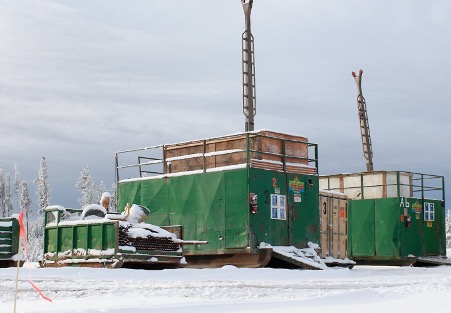Fission Uranium Corp. (TSX:FCU) has welcomed the results of a positive Feasibility Study conducted on the Patterson Lake South Uranium Property in Canada’s Athabasca Basin region.
The impressive FS results further enhance the robust economics outlined in the 2019 pre-feasibility study.
Highlights include a longer mine life of 10 years, greatly increased after-tax NPV of C$1.204B at 8% discount, higher after-tax IRR of 27.2% while still maintaining a very low OPEX of C$13.02/lb.
The results confirm the economic strength of the PLS project as well as its minimal environmental footprint. With nuclear energy and the uranium sector strengthening year on year, Fission is ideally positioned to continue developing PLS through the environmental assessment and licensing phase. The FS has an effective date of January 17, 2023.
“With greatly enhanced economics, including an increase of 42% to the mine life, an incredible 71.5% increase in post-tax NPV and a 10.2% growth in post-tax IRR, this feasibility study confirms the Tier 1 PLS project as one of the most economically significant and elite uranium development projects in the world,” President and CEO, Ross McElroy, said.
“Showing CAPEX to be lower than in the 2019 Prefeasibility report, particularly with the pressures of high global inflation, is a remarkable achievement and speaks volumes regarding the team’s design and planning abilities.
“Beyond the economics, the shallow, high-grade nature of our deposit gives us a very small environmental footprint – an advantage that we have built on with comprehensive monitoring since the start of drilling in 2012 and increasing Indigenous engagement.
“Going forward, thanks to the strength of this feasibility study and the success of our ongoing social engagement, we will continue advancing through the Environmental Assessment and on towards a construction decision .”
Feasibility Study Highlights
- Construction timeline of three years with an estimated initial capital cost of C$1.155B
- Increased mine life to ten years with LOM production of 90.9 million lbs of U 3 O 8
- Addition of R840W orebody into the FS mine plan contributing to increased Mineral Reserves
- Average unit operating cost of C$13.02/lb U 3 O 8
- Robust post-tax economics:
- IRR of 27.2%
- NPV of $1.204B at 8% discount
- Payback period of 2.6 years
Scope for Resource Growth
While the FS only considers Indicated Resources from the R780E, R840W and R00E zones, the mine plan has been deliberately designed to easily accommodate additional material from the R1515W and R1620E zones based on the potential future conversion of Inferred Resources to Indicated Resources.
The majority of mineralization at these two on-strike, high-grade zones is currently defined as Inferred Mineral Resource classification and thus not considered for inclusion in the FS mine plan.
As proven by the company’s drilling at the Triple R deposit’s R780E, R840W and R00E zones, Fission has an excellent track record of converting Inferred-category resources to Indicated-category. As a result, there is a clear path for growing the deposit, potentially leading to an increased resource as well as a longer mine life.
- Mine Life and Zone Expansion: The FS mine plan has increased the mine life to 10 years. Both the R780E and R840W zones are open at depth and along the plunge to the east. Further opportunity exists to grow the resource in those directions, potentially extending the underground mine life even further.
- Additional Zones: The FS mine plan has a future opportunity to accommodate the potential conversion of Inferred Resources to Indicated Resources at two high-grade, on-strike zones – R1515W and R1620E – that are not yet part of Mineral Reserves.
- Mineralization Upgrade: The FS mine plan does not include areas of Inferred Mineral Resources in the R00E, R840W and R780E zones. An opportunity exists to upgrade to Indicated Mineral Resource with future planned drilling.
Reduced Environmental Impact
- The underground mine plan eliminates direct physical impacts on Patterson Lake and the Clearwater River drainage. Other than a dock, freshwater intake and treated effluent diffuser, all other infrastructure related to mining and processing at PLS is set back to maintain an acceptable riparian buffer to the shoreline of Patterson Lake.
- The revised Project layout maintains a compact footprint, and facilities have been placed to avoid local areas of old-growth jack pine forest and heritage resource sites.
- In the absence of hydro utilities, using LNG for site power generation instead of diesel, while only marginally reducing the greenhouse gases, significantly decreases emissions of particulates and sulphur and nitrogen compounds.
- Metallurgical test work indicates that the Project will be able to meet the water quality ranges for treated effluent discharges found at other uranium mining operations in Saskatchewan .
- Modelling of the Tailings Management Facility (TMF) interactions with groundwater indicates that the current design will be protective of groundwater quality in the long term and thus protective of the Patterson Lake drainage.
- At year-end 2022, Fission had engagement agreements with all the Indigenous groups with the potential for impacts to their traditional land use and treaty rights due to the Project.
- Fission responded to local concerns over the proposed bypass of Highway 955 around the site by leaving the road route as it is.
For further information please visit: https://fissionuranium.com












